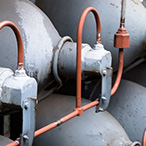Pulsar Helium Reports Pre-Feasibility Study Results for Tunu Project

Sproule-ERCE study identifies geothermal reservoir with temperatures of 80-130°C and evaluates combined power generation and helium extraction scenarios.
- Independent pre-feasibility study by Sproule-ERCE identifies geothermal system with reservoir temperatures of 80-130°C and assesses potential for combined renewable power and helium production.
- Reservoir modelling indicates potential helium recovery of approximately 350,000 cubic feet per day in high-case scenarios, representing a primary helium resource unassociated with hydrocarbons.
- Binary cycle and dual-flash geothermal power systems identified as feasible options with estimated capital expenditure of $20-30 million, potentially supplying power to Ittoqqortoormiit settlement.
- Greenland and Denmark governments announced funding for new airport at Ittoqqortoormiit with construction scheduled for 2026-2029, providing year-round access adjacent to project site.
- Company holds exclusive Mineral Exploration Licence 2025/101 with initial five-year term, extendable to 22 years.
Pulsar Helium Inc. (AIM: PLSR, TSXV: PLSR, OTCQB: PSRHF) is a helium project development company with two projects: the Topaz helium project in Minnesota, USA, and the Tunu helium project in Greenland. Both locations feature primary helium occurrences not associated with hydrocarbon production.
Pre-Feasibility Study Results and Geothermal-Helium Dual Production Potential
The independent pre-feasibility study conducted by Sproule-ERCE analysed hot spring samples indicating underground temperatures of 80-130°C. The study assessed binary cycle and dual-flash geothermal power systems as potential development options for the site. Data in the area remains limited, and feasibility has not been confirmed.
Reservoir analytical modelling indicates potential flow rates of up to approximately 720 cubic metres per hour in optimal scenarios. Under these conditions, a single well pair could supply geothermal power to the settlement of Ittoqqortoormiit and provide an additional 4.2 megawatts for helium processing operations. The study estimates capital expenditure of $20-30 million for the proposed facilities.
In high-case scenarios, daily helium production could reach approximately 350,000 cubic feet.
Thomas Abraham-James, President and CEO, stated:
"With minimal existing infrastructure in East Greenland, the ability to power our planned helium plant directly from geothermal energy is transformative, delivering clean, baseload electricity to the local community while simultaneously reducing our operational expenses as we develop a pathway towards sustainable helium production."
Infrastructure Development and New Airport at Ittoqqortoormiit
The governments of Greenland and Denmark announced funding for a new airport at Ittoqqortoormiit with construction scheduled from 2026 to 2029. The facility will be located adjacent to the Tunu project site. Currently, the region is accessible only seasonally by ship and charter flights.
The airport is expected to provide year-round access and reduce logistical costs for field programmes and construction activities. The infrastructure development addresses existing seasonal constraints that limit exploration activities. Equipment, personnel, and materials will be transportable throughout the year once the facility is operational.
The airport construction timeline aligns with Pulsar's exploration schedule. As the company advances through the recommended 2026 exploration programme, the airport construction will proceed, with the facility positioned to support subsequent phases of activity at the site.
Exploration Progress and Future Programme Recommendations
Over the past 18 months, Pulsar has conducted surface exploration that identified hot springs with helium concentrations up to 0.8%. Early findings established the presence of helium at the site. In 2024, the company executed a passive seismic survey across the Kap Tobin prospect using 150 sensors.
The survey identified two low-velocity anomalies between 50 and 200 metres depth, coincident with surface hot springs and a major fault system. These anomalies are interpreted as fractured reservoirs. The data indicated fracturing levels above initial expectations. To build on these results, Pulsar engaged Sproule-ERCE in June 2025 to conduct the pre-feasibility study.
Sproule-ERCE recommends a 2026 programme including magneto-telluric surveys, additional hot spring sampling, and a slim appraisal well to measure reservoir conditions.
Thomas Abraham-James commented:
"The results of this independent Pre-Feasibility study, combined with the announcement of a new airport at Ittoqqortoormiit, highlight the extraordinary potential of the Tunu Project. Tunu is not only one of the very few primary helium prospects in Europe, but also a project that aligns perfectly with Greenland and Europe's future energy and critical raw material needs."
Next Steps
Pulsar Helium plans to execute the recommended 2026 exploration programme, including magneto-telluric surveys and hot spring sampling to characterise the subsurface geothermal system. Following surface studies, the company plans to drill a slim appraisal well to measure reservoir conditions, flow rates, and helium concentrations. The pre-feasibility study results, planned airport infrastructure, and the company's exploration licence provide the basis for the next phase of project activity.
Analyst's Notes




Subscribe to Our Channel
Stay Informed













